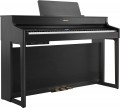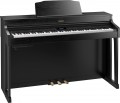Built-in timbres
The number of built-in sounds provided by the Digital Piano.
Despite the name, digital pianos are extremely rarely designed to imitate the sound of only a piano — the electronic hardware allows them to provide other timbres of sound. In addition, even the piano has its own varieties — for example, among the grand pianos there are 6 main classes, from large concert to miniature. So the built-in sounds can cover different kinds of pianos, as well as other instruments and sound effects.
The abundance and variety of timbres in digital pianos as a whole is not as great as in synthesizers, however, in this category there are very “charged” models, with a hundred timbres or more (in the most multifunctional, this number can exceed 900). However, it is worth specifically looking for a “multi-instrumental” model if you do not intend to be limited to the sound of the piano and would like to have more freedom of choice. It is worth remembering that a specific set of timbres can be different.
If the instrument is bought exclusively as a piano, then here, on the contrary, it is worth paying attention primarily to solutions with a small number of timbres. Such models are not only cheaper than "universals" — they can also sound better (due to the fact that there are few timbres and the manufacturer can carefully approach the sound quality of each built-in "instrument").
Octave shift
The presence of an octave shift function in the digital piano.
This function makes it possible to "shift" the sound by a certain number of octaves up or down — for example, in such a way that the bass register sounds on the keys of the first octave, or vice versa, the first octave "slid" lower, into the bass, and notes of the second sounded in its place or even the third octave.
This feature significantly expands the range of the instrument, allowing you to play notes that were not originally covered by the keyboard. This is especially important for instruments with 61 or 73 keys (see "Number of Keys"), but
octave shifting is not uncommon in full-sized 88-key models — it can be useful when splitting the keyboard (see above), when available for each hand the range is noticeably reduced, and the batch can be very low or very high. However, there are other options for using transfer — for example, so that when playing an updated version of the melody, you do not have to move from the usual octaves.
Reverberation
The ability to add a reverb effect to the sound of the instrument.
Reverb is the repeated reflection and decay of sound. Most of all, this effect is noticeable in vast spaces with a pronounced echo — for example, large caves; however, in any environment, the coloring of the sound characteristic of such an environment is mainly due to reverberation. Thus, this function allows you to simulate music that sounds in different rooms — for example, to give the impression that the instrument is in the hall of a Gothic cathedral, or, conversely, in a small room with soft walls. However, it is also possible to use reverberation as a classic sound effect, which is not aimed at simulating the situation and only gives the sound a specific colour.
Built-in acoustics
The power of the native acoustics installed in the Digital Piano.
This indicator directly affects the maximum volume that the instrument is able to produce "on its own", without connecting external speakers. At the same time, it is worth noting that many manufacturers go to the trick and indicate in the characteristics not the rated power (rms power when operating at full volume), but the peak power, which is the highest power that the acoustics can deliver at short “ups” of volume. Peak power values can be quite impressive — in the tens and hundreds of watts — but these figures have a very indirect relation to the actual capabilities of the speakers. Therefore, before choosing, it is worth clarifying what kind of power is mentioned in the characteristics. To do this, it is not necessary to look for detailed data on the instrument, it is enough to compare the power of the speakers with the power consumption (see below): if the claimed power of the acoustics is greater than the power consumption of the entire instrument, then the manufacturer indicated exactly the peak value.
Power consumption
The power consumed by the tool during normal operation.
The cost of electricity, as well as connection requirements, depend on this indicator. At the same time, we note that digital pianos require relatively little energy — even in the most powerful and advanced models, consumption usually does not exceed 60 watts. So in fact, power consumption data is required mainly for specific cases — for example, to calculate the total load when connecting a tool to an autonomous generator along with other devices. In addition, this information may be useful when assessing the power of the built-in speaker, for more information, see "Built-in acoustics".

